Successful targeting of specimen fish from rough ground fishing marks requires a robust and methodical approach. I have been fishing North Devon’s wild and rugged coastline for many years and have witnessed plenty of specimen fish landed and even managed to land a few myself. In recent years my success has tailed off to some extent, one reason for this has been a reduction in my efforts. For as with most anglers there are other aspects of life that impact upon the time available to spend targeting fish. Not making excuses here, just stating a fact that my priorities have perhaps changed to some extent and life’s balance has shifted.
So the question is how to get the best results from your available time? There are many factors that impact upon when to fish so let’s focus upon the key aspects. Remember, to get success you need to be in THE RIGHT PLACE AT THE RIGHT TIME! Refining this you should be offering top quality bait, presented carefully on sharp top quality hooks. The rig must be effective and the tackle used adequate to bring the hooked fish to the shoreline. If fishing from rocks or an elevated platform landing equipment will be required to lift the fish from the water.
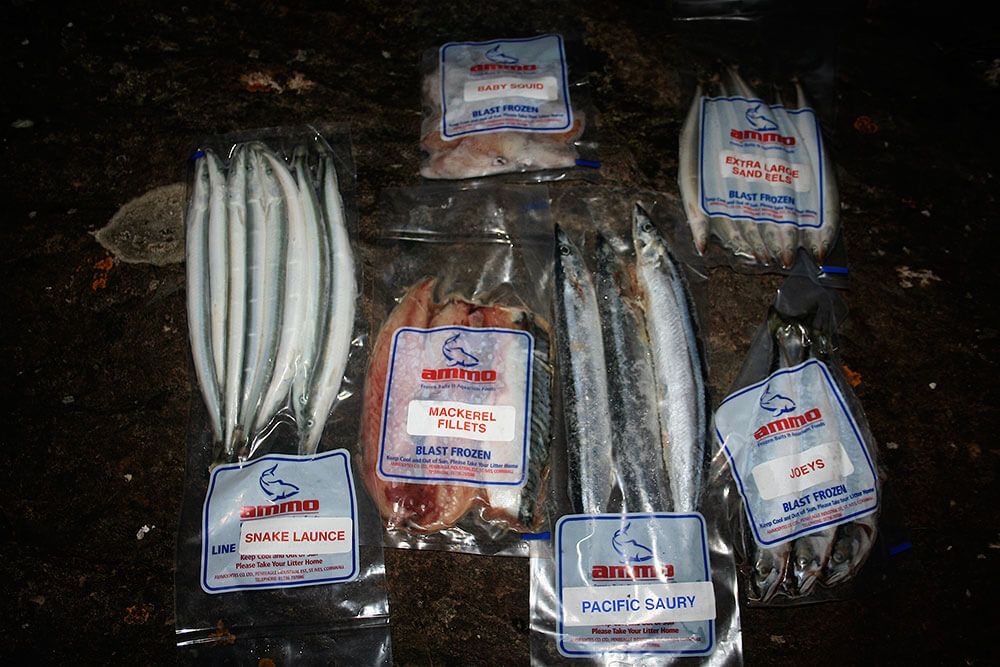
All of the above is very obvious and simple; so why is it that only a small percentage of anglers catch the biggest specimens? The statistic becomes very apparent when I look through the catch records of the club I have belonged to for many years. Combe Martin Sea Angling Club members have enjoyed a great deal of success over many seasons and the clubs record list makes impressive reading. Throughout the year we run a best specimen competition and this tends to be dominated by the same anglers, a small band of dedicated souls who have a knack of finding those specimens. A downside of this is that it can deter some members from taking part as they believe that success only comes from investing many hours that they do not have!
This is to some extent a misconception, whilst it is true that time equals fish it is not as simple as that. As I said earlier in the article, I do not get out as much as I would like but I do take care in choosing when I go. I fish with various other anglers ranging from long term experienced anglers like myself and relative beginners who are keen to learn. The contrasting company highlights a frequent factor in my fishing trips. When I fish with dedicated experienced anglers, I often end up behind the camera and clambering down to the waters edge wielding a gaff or landing net. On the other hand when I take a less experienced angler I tend to come out on top asking them to take my picture cradling the fish of the night.
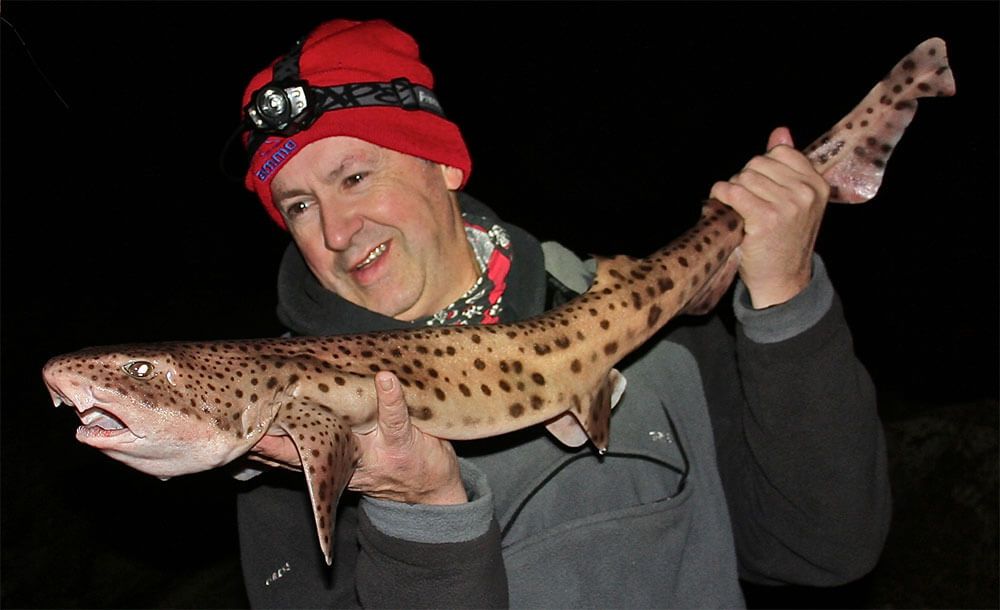
So what are the edges that lead to more success for some anglers? Belief is certainly a factor, for this brings confidence, a vital ingredient in any aspect of fishing. Belief of course emanates from success hence the fact that anglers often appear to be on a roll catching numerous specimens in a season. This is seldom luck, though this can play its part.
So to be in the right place at the right time what factors must we consider? Experience is undoubtedly a key factor here but this can only be gained with the passing of time. It is beneficial to keep a log of catches recording all relevant factors. Knowledge of the topographical details are essential, if possible visit the venues you intend to fish at low water and look carefully for features such as gullies, weed, rocks and snags, food sources, streams or rivers entering the sea. How will the weather impact upon the venue? Note wind direction and consider how the wind will impact upon the fishability of the mark.
Choice of venue will be made according to target species, safety and preference. Historic data will help to indicate what species are likely to be present. Weather, tide and previous experience and advice from other anglers will determine safety of the mark. As to preference well is it a place you wish to spend your time? If you only have time for a short session then an easily accessible mark will be preferable to one that requires a miles walk to reach. It is worth considering though that two hours in the right spot is far better than eight hours in the wrong one.
On a recent session I joined two fellow Combe Martin SAC members, Kevin Legge and Dave Brooke in search of huss, conger and spurdog. The mark we had elected to fish gives access to deepwater with a proven track record for producing big fish of many species. It was a Saturday so we had no serious restraint on time hence the half an hour walk to the venue was not an issue. High water was at 10.00pm and with the westerly breeze that was blowing we knew the mark would be partially sheltered. We elected to arrive at the venue for around 4.00pm this would allow us to descend to the mark in daylight and tackle up getting our baits into the water as the light faded, a time when fish often feed hard.
We tackled up two rods each but only used one each as this reduced the risk of tangled lines. As the mark is relatively snaggy having a second rod ready would ensure we always had bait in the water. The basic setup for this mark was a pulley rig attached to an 80lb leader, 25lb main line. The pulley rig consisted of 100lb rig body and a hook length of 100lb plus mono or 150lb wire. A Pennel rig of Sakuma Manta Extra 4/0 to 6/0 completed the set up. The hooks were baited with Ammo dirty squid, mackerel or cuttlefish. A 6oz to 7oz grip lead anchors the bait to the sea bed attached via a weak link of 18lb line . Note this is relatively heavy gear if compared to that recommended in many articles. It is my belief and Kevin’s that the hook length seldom deters fish during the winter months when fishing rough ground especially during the hours of darkness or when the water is coloured.
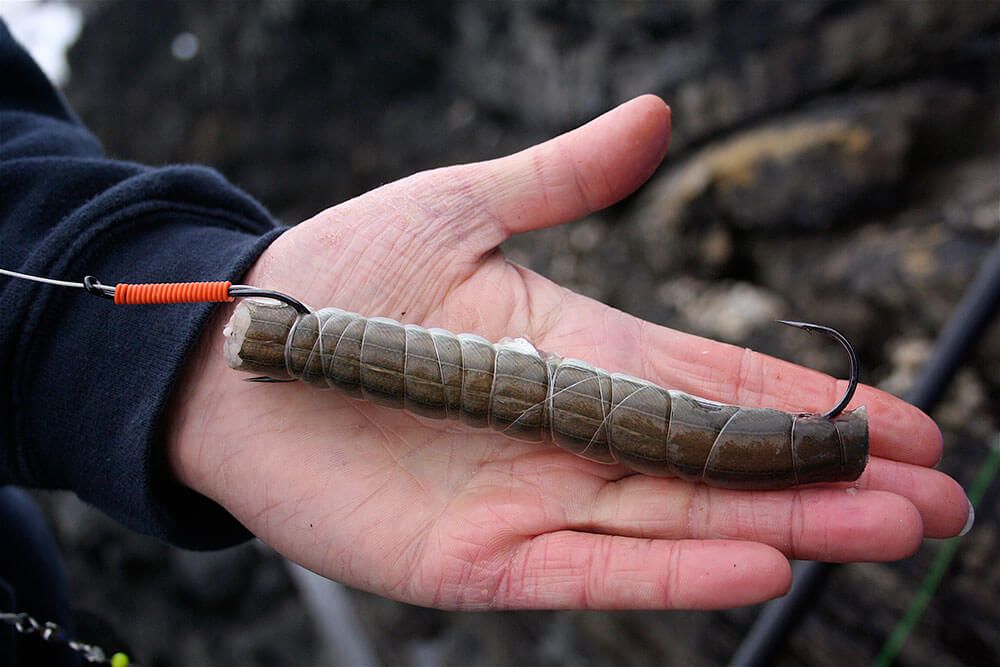
With three of us fishing the mark careful casting was required to reduce the risk of crossed lines. The strong tidal flow meant that we all had to cast uptide to a varying degree. On casting out it is important to allow the weight to sink to the bottom and then pay out plenty of slack to encourage the weight to get a grip. I see many beginners cast out and engage the reel as soon as the bait hits the water; they then tighten up to find that their tackle has been swept down tide possibly entangling that of neighbouring anglers.
I always relish the start of a session settling back after casting out. With the baits anchored to the bottom its time to tidy the tackle, ensure the headlight is still in working order. We all lean back against the rocks, pouring a coffee or perhaps lighting a cigarette, time to take a look around, take in the scenery and recover from the strenuous descent to the mark.
For the next six hours focus will be upon the rod tips as they nod and sway to the pull of the tide. If our luck is in they will from time to time bounce with a more pronounced vibe as a fish intercepts the offering anchored to the seabed in a dark and mysterious world into which our lines disappear.
Assembled beside us on the rocks we have a long handled gaff and a long handled capacious net. We have taken a look over the edge of the rocks to plan a safe descent to waters edge should a good fish be hooked. No good leaving this until a fish is hooked, always have a plan in place and carry out a risk assessment. When descending the rocks to land a fish ensure you have a good headlight, good grips on your boots and most importantly keep a close eye upon the sea, watch out for a swell that can sweep the unwary to an early grave. Do not get too close to the water until the fish is within reach. Then when the fish is ready step down and carefully wield the net or gaff. Do not grab the line except to perhaps guide the fish towards the net allowing the line to run freely between the fingers.
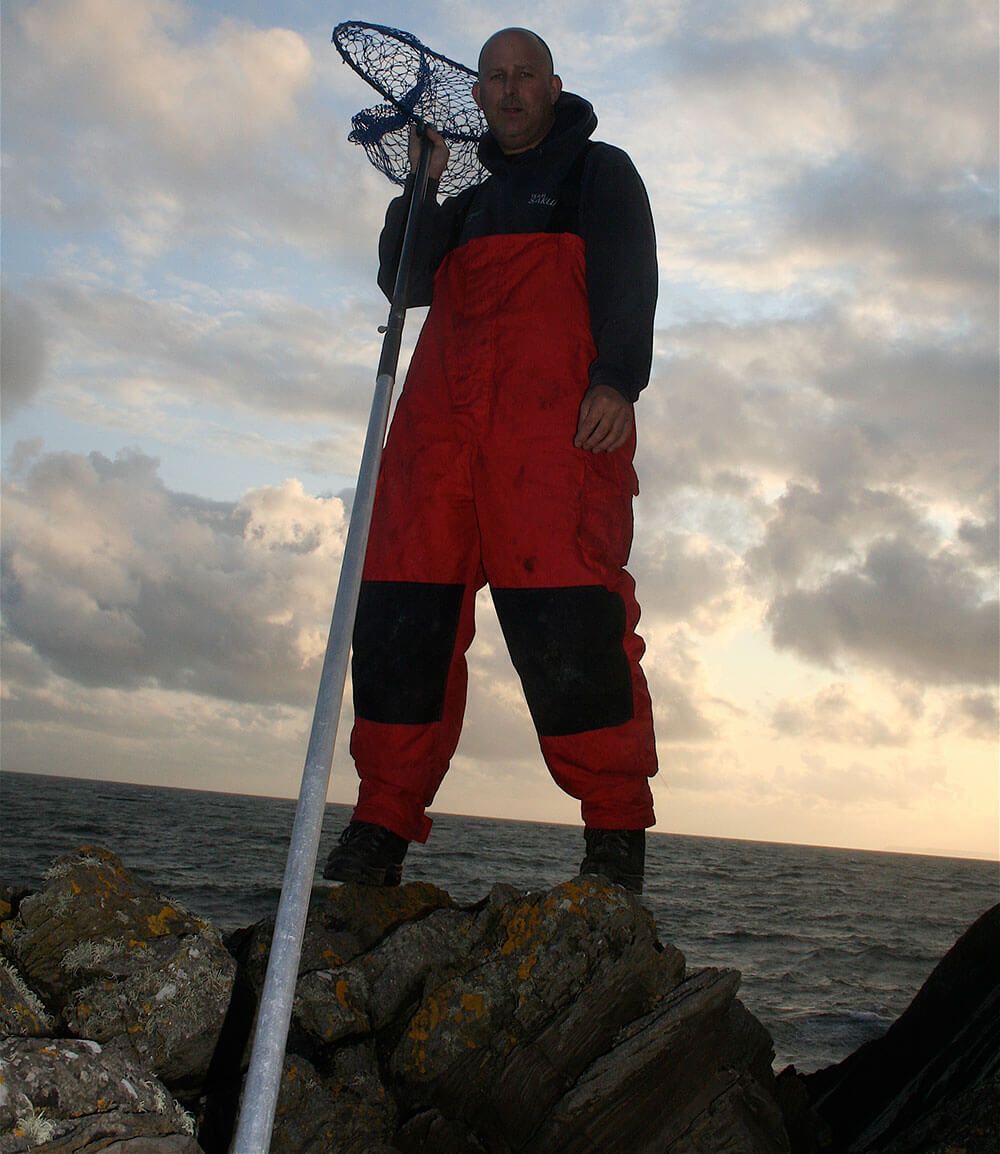
The control of the fish should be left to the angler holding the rod. Ensure that you both communicate with each other and know what each is doing. The angler holding the rod should slacken off the reels clutch when the fish is gaffed or netted just in case something goes wrong and the fish falls back to the water.
Back to our session now and after an hour the rod tips have nodded briskly a few times and several dogfish have been swung ashore often taking the baits quite deep despite the use of big baits and large hooks.
Patience is often required when trying to determine what is happening at the business end. Only when a decisive movement of the rod is detected should the rod be raised smoothly and the reel cranked to set the hook and get the fish moving ashore.
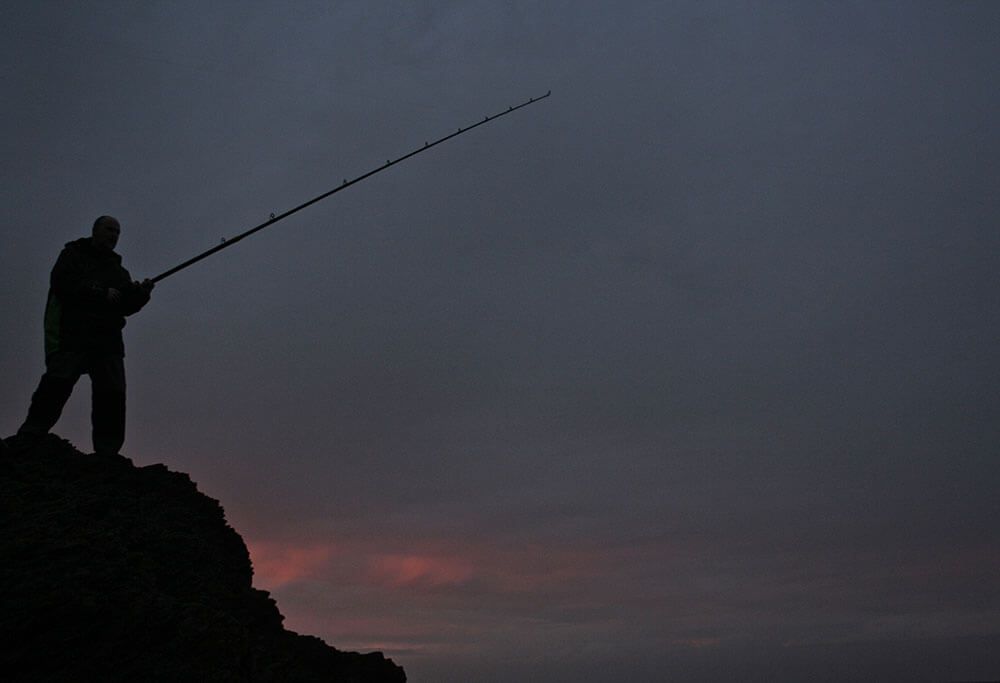
Dave Brooke notices a couple of positive dips of his rod tip and picks up the rod. He now begins to analyse what is happening. After a couple of minutes Dave is sure that the fish has taken the bait. As the fish moves away Dave points the rod down the line then starts to crank the reels handle smoothly raising the rod. When the rod is fully compressed Dave winds the reels handle as the rod is lowered to take up the line. The rod is now absorbing the lunges of a good fish out in the dark depths. General consensus is that it’s a conger and I descend the rock ledges gaff at the ready. Keeping a safe distance from the surging swell I wait for the first glimpse of the prize as Dave persuades the powerful fish towards the waters edge and waiting gaff. At just over 18lb it’s a pleasing start to the session and not far short of the clubs twenty-pound specimen rating.
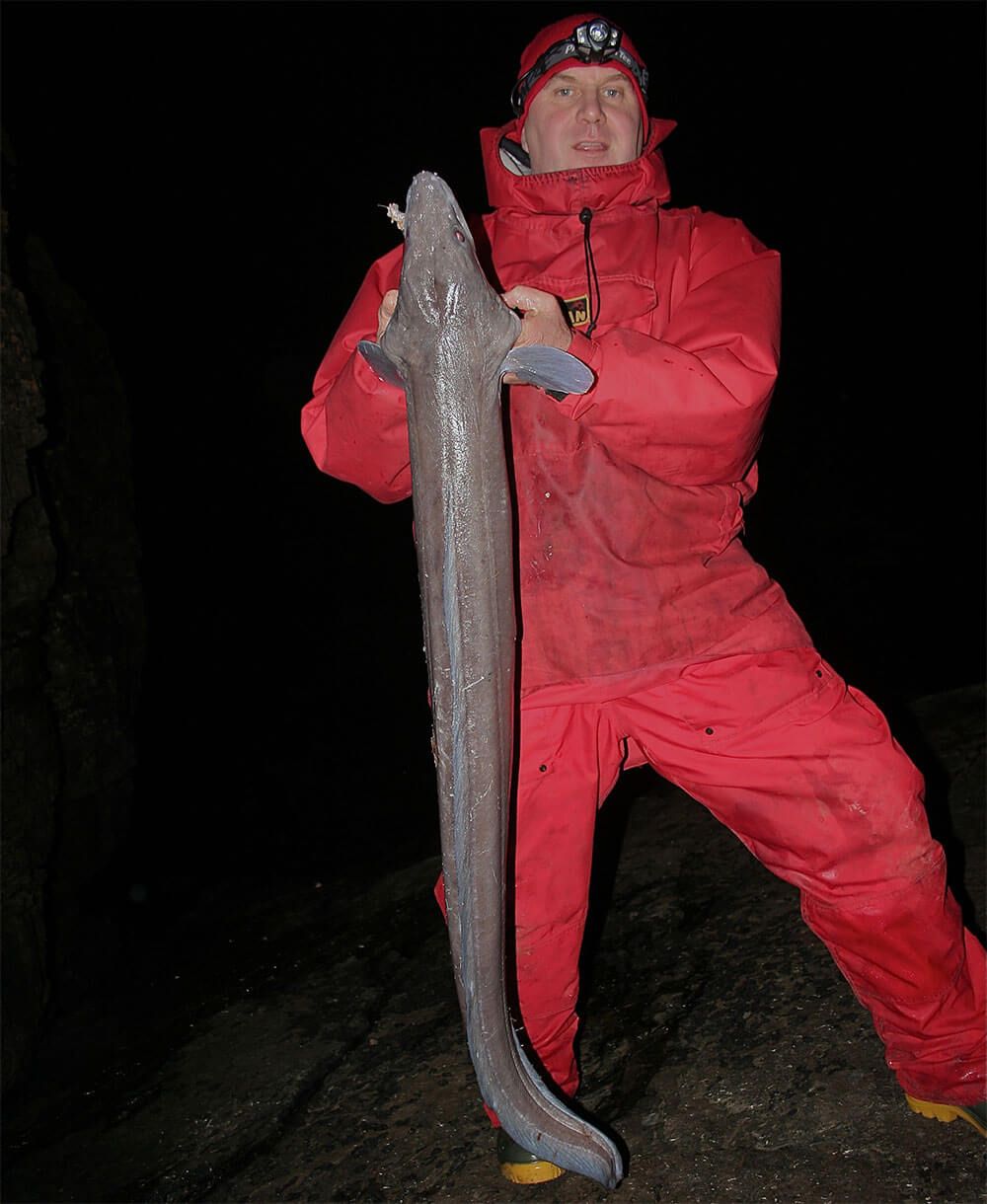
A short time later Kevin hooks into a better fish and I again descend the rocks this time with the net as we believe this is no conger. The blue grey back indicates that it is a spurdog that has grabbed Kevin’s cuttlefish bait. At 7lb 12oz it’s just four ounces off specimen size and a very welcome catch.
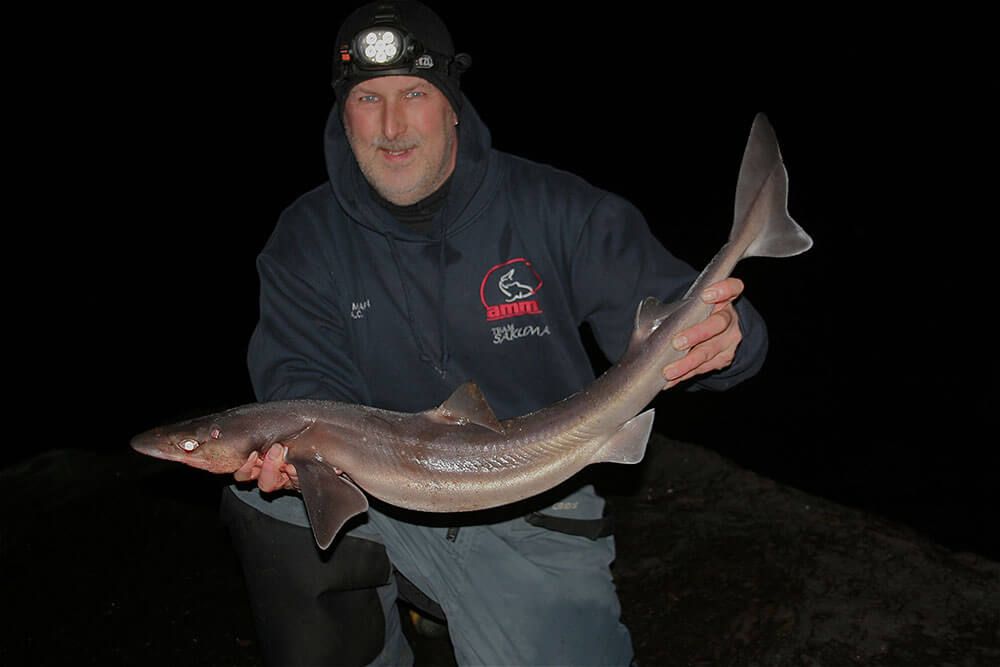
Several dogfish follow along with a couple of smaller conger. I hook a conger of around eight pounds that I am able to hand line from the water without a problem.
Then as high water passes, Kevin again hooks a better fish and once again I wield the net. This time its a big bull huss that comes into view as we peer into the water with our headlights illuminating the surging waves. Bull huss are notorious for ejecting the bait as they reach the surface so it’s a relief when the huss is safely ensconced within the net. At 12lb 3oz the fish is well above the clubs specimen size target. The camera is carefully used to ensure a permanent record of the fish.
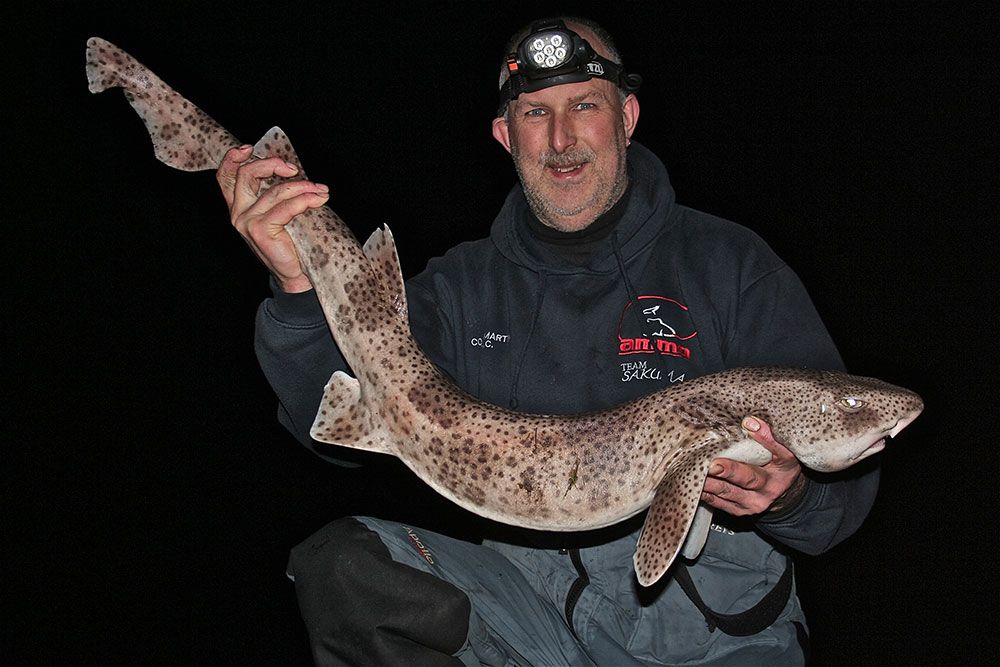
Getting good photos requires a degree of care and thought. Get the angler to turn off their headlight, make sure they hold the fish firmly showing it off at the best angle. Ensure that you fill the frame with fish and angler. Look out for distracting items in the frame like plastic bags etc. If you do not wish others to know where you caught the fish try to avoid showing giveaway features on the rocks.
As always the session has flown past quickly and its time to make the climb back up the cliff. At the end of the session always make sure you takeaway all the old bait wrappers and any line or hooks. Many marks have been lost to anglers as a result of the careless disposal of litter, there really is no excuse.
As walk up the winding path we pause from time to time to admire the view across the Bristol Channel to the glimmering lights of Wales and also of course to catch our breath as we are not getting any younger!
So the question is how to get the best results from your available time? There are many factors that impact upon when to fish so let’s focus upon the key aspects. Remember, to get success you need to be in THE RIGHT PLACE AT THE RIGHT TIME! Refining this you should be offering top quality bait, presented carefully on sharp top quality hooks. The rig must be effective and the tackle used adequate to bring the hooked fish to the shoreline. If fishing from rocks or an elevated platform landing equipment will be required to lift the fish from the water.

All of the above is very obvious and simple; so why is it that only a small percentage of anglers catch the biggest specimens? The statistic becomes very apparent when I look through the catch records of the club I have belonged to for many years. Combe Martin Sea Angling Club members have enjoyed a great deal of success over many seasons and the clubs record list makes impressive reading. Throughout the year we run a best specimen competition and this tends to be dominated by the same anglers, a small band of dedicated souls who have a knack of finding those specimens. A downside of this is that it can deter some members from taking part as they believe that success only comes from investing many hours that they do not have!
This is to some extent a misconception, whilst it is true that time equals fish it is not as simple as that. As I said earlier in the article, I do not get out as much as I would like but I do take care in choosing when I go. I fish with various other anglers ranging from long term experienced anglers like myself and relative beginners who are keen to learn. The contrasting company highlights a frequent factor in my fishing trips. When I fish with dedicated experienced anglers, I often end up behind the camera and clambering down to the waters edge wielding a gaff or landing net. On the other hand when I take a less experienced angler I tend to come out on top asking them to take my picture cradling the fish of the night.

So what are the edges that lead to more success for some anglers? Belief is certainly a factor, for this brings confidence, a vital ingredient in any aspect of fishing. Belief of course emanates from success hence the fact that anglers often appear to be on a roll catching numerous specimens in a season. This is seldom luck, though this can play its part.
So to be in the right place at the right time what factors must we consider? Experience is undoubtedly a key factor here but this can only be gained with the passing of time. It is beneficial to keep a log of catches recording all relevant factors. Knowledge of the topographical details are essential, if possible visit the venues you intend to fish at low water and look carefully for features such as gullies, weed, rocks and snags, food sources, streams or rivers entering the sea. How will the weather impact upon the venue? Note wind direction and consider how the wind will impact upon the fishability of the mark.
Choice of venue will be made according to target species, safety and preference. Historic data will help to indicate what species are likely to be present. Weather, tide and previous experience and advice from other anglers will determine safety of the mark. As to preference well is it a place you wish to spend your time? If you only have time for a short session then an easily accessible mark will be preferable to one that requires a miles walk to reach. It is worth considering though that two hours in the right spot is far better than eight hours in the wrong one.
On a recent session I joined two fellow Combe Martin SAC members, Kevin Legge and Dave Brooke in search of huss, conger and spurdog. The mark we had elected to fish gives access to deepwater with a proven track record for producing big fish of many species. It was a Saturday so we had no serious restraint on time hence the half an hour walk to the venue was not an issue. High water was at 10.00pm and with the westerly breeze that was blowing we knew the mark would be partially sheltered. We elected to arrive at the venue for around 4.00pm this would allow us to descend to the mark in daylight and tackle up getting our baits into the water as the light faded, a time when fish often feed hard.
We tackled up two rods each but only used one each as this reduced the risk of tangled lines. As the mark is relatively snaggy having a second rod ready would ensure we always had bait in the water. The basic setup for this mark was a pulley rig attached to an 80lb leader, 25lb main line. The pulley rig consisted of 100lb rig body and a hook length of 100lb plus mono or 150lb wire. A Pennel rig of Sakuma Manta Extra 4/0 to 6/0 completed the set up. The hooks were baited with Ammo dirty squid, mackerel or cuttlefish. A 6oz to 7oz grip lead anchors the bait to the sea bed attached via a weak link of 18lb line . Note this is relatively heavy gear if compared to that recommended in many articles. It is my belief and Kevin’s that the hook length seldom deters fish during the winter months when fishing rough ground especially during the hours of darkness or when the water is coloured.

With three of us fishing the mark careful casting was required to reduce the risk of crossed lines. The strong tidal flow meant that we all had to cast uptide to a varying degree. On casting out it is important to allow the weight to sink to the bottom and then pay out plenty of slack to encourage the weight to get a grip. I see many beginners cast out and engage the reel as soon as the bait hits the water; they then tighten up to find that their tackle has been swept down tide possibly entangling that of neighbouring anglers.
I always relish the start of a session settling back after casting out. With the baits anchored to the bottom its time to tidy the tackle, ensure the headlight is still in working order. We all lean back against the rocks, pouring a coffee or perhaps lighting a cigarette, time to take a look around, take in the scenery and recover from the strenuous descent to the mark.
For the next six hours focus will be upon the rod tips as they nod and sway to the pull of the tide. If our luck is in they will from time to time bounce with a more pronounced vibe as a fish intercepts the offering anchored to the seabed in a dark and mysterious world into which our lines disappear.
Assembled beside us on the rocks we have a long handled gaff and a long handled capacious net. We have taken a look over the edge of the rocks to plan a safe descent to waters edge should a good fish be hooked. No good leaving this until a fish is hooked, always have a plan in place and carry out a risk assessment. When descending the rocks to land a fish ensure you have a good headlight, good grips on your boots and most importantly keep a close eye upon the sea, watch out for a swell that can sweep the unwary to an early grave. Do not get too close to the water until the fish is within reach. Then when the fish is ready step down and carefully wield the net or gaff. Do not grab the line except to perhaps guide the fish towards the net allowing the line to run freely between the fingers.

The control of the fish should be left to the angler holding the rod. Ensure that you both communicate with each other and know what each is doing. The angler holding the rod should slacken off the reels clutch when the fish is gaffed or netted just in case something goes wrong and the fish falls back to the water.
Back to our session now and after an hour the rod tips have nodded briskly a few times and several dogfish have been swung ashore often taking the baits quite deep despite the use of big baits and large hooks.
Patience is often required when trying to determine what is happening at the business end. Only when a decisive movement of the rod is detected should the rod be raised smoothly and the reel cranked to set the hook and get the fish moving ashore.

Dave Brooke notices a couple of positive dips of his rod tip and picks up the rod. He now begins to analyse what is happening. After a couple of minutes Dave is sure that the fish has taken the bait. As the fish moves away Dave points the rod down the line then starts to crank the reels handle smoothly raising the rod. When the rod is fully compressed Dave winds the reels handle as the rod is lowered to take up the line. The rod is now absorbing the lunges of a good fish out in the dark depths. General consensus is that it’s a conger and I descend the rock ledges gaff at the ready. Keeping a safe distance from the surging swell I wait for the first glimpse of the prize as Dave persuades the powerful fish towards the waters edge and waiting gaff. At just over 18lb it’s a pleasing start to the session and not far short of the clubs twenty-pound specimen rating.

A short time later Kevin hooks into a better fish and I again descend the rocks this time with the net as we believe this is no conger. The blue grey back indicates that it is a spurdog that has grabbed Kevin’s cuttlefish bait. At 7lb 12oz it’s just four ounces off specimen size and a very welcome catch.

Several dogfish follow along with a couple of smaller conger. I hook a conger of around eight pounds that I am able to hand line from the water without a problem.
Then as high water passes, Kevin again hooks a better fish and once again I wield the net. This time its a big bull huss that comes into view as we peer into the water with our headlights illuminating the surging waves. Bull huss are notorious for ejecting the bait as they reach the surface so it’s a relief when the huss is safely ensconced within the net. At 12lb 3oz the fish is well above the clubs specimen size target. The camera is carefully used to ensure a permanent record of the fish.

Getting good photos requires a degree of care and thought. Get the angler to turn off their headlight, make sure they hold the fish firmly showing it off at the best angle. Ensure that you fill the frame with fish and angler. Look out for distracting items in the frame like plastic bags etc. If you do not wish others to know where you caught the fish try to avoid showing giveaway features on the rocks.
As always the session has flown past quickly and its time to make the climb back up the cliff. At the end of the session always make sure you takeaway all the old bait wrappers and any line or hooks. Many marks have been lost to anglers as a result of the careless disposal of litter, there really is no excuse.
As walk up the winding path we pause from time to time to admire the view across the Bristol Channel to the glimmering lights of Wales and also of course to catch our breath as we are not getting any younger!

